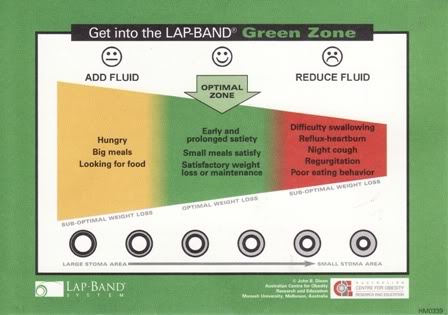Get Into The Green Zone

GET INTO THE GREEN ZONE
Bandsters tend to obsess about finding their sweet spot** or perfect restriction, and in the process torturing themselves with the idea that weight loss won’t start until they reach that magic place. That’s kind of like trying to balance yourself on the pointy peak of a pyramid, where you’re all too likely to fall off and crash into the ground. Focusing on finding that one special spot (instead of appreciating what our bands are doing for us right now) is short-changing yourself. It’s kind of like sex: if you don’t pay close enough attention to how you feel now, you’re not going to appreciate the many small, pretty-good moments that lead up to and follow the one great moment. To my mind, it’s more helpful to use the term Green Zone.
Allergan, the manufacturer of the Lap-Band®, developed the Green Zone chart as a simple, visual way to explain the band’s performance without using the terms sweet spot or restriction. I agree with that approach. In my personal experience, it’s far better to think of restriction as a range of experience rather than a single point on a line. I’d really like to drop the term restriction altogether because it’s an outdated term from the olden days when adjustable gastric band was labeled a “restrictive” device that automatically limits how much the patient can eat. I prefer the term “optimization” - a band system functioning at its best. That system consists of the band and the patient who is taking responsibility for good food choices (both for satiety and for health) and portion control, plus fighting the good fight against emotional and addictive eating.
But having said all that, I’m going to go on using the term restriction because it’s more easily recognized by bandsters than the term optimization. Just keep in mind that when I mention restriction, I'm referring only to the signals the band system uses to communicate its status and/or need for adjustment. Let’s take a look at some of those indicators. They are signposts that can be hard to read until you’ve learned your band’s and your body’s idiosyncrasies.
** To read more about the sweet spot, click here:
http://www.lapbandtalk.com/page/index.html/_/support/post-op-support/the-elusive-sweet-spot-r59
YELLOW ZONE - hungry; eating big meals; looking for food Ü add fluid
This is territory that new bandsters often find themselves in – also known as “bandster hell.” We don’t have enough fluid in our bands yet, and at this point, the patient has to work harder at weight loss. The yellow zone is very frustrating, but it doesn’t mean that your band is broken. It just means that your band system needs some tweaking.
GREEN ZONE - early & prolonged satiety; satisfactory weight loss or maintenance J no fluid adjustment needed
The Green Zone is the bandster’s Promised Land, where the patient and his/her band work in tandem to achieve weight loss or weight maintenance. It isn’t a worry-free or work-free zone – like many other good things, it needs attention, consistency, and plenty of work – but it’s a wonderful place to live.
RED ZONE - difficulty swallowing; reflux-heartburn; night cough; regurgitation; poor eating behavior Ü remove fluid.
You may find yourself in the red zone when your band is too tight. That can happen even when you haven’t recently had a fill, and for a variety of reasons, many of them benign if frustrating.
BE YOUR OWN TRAVEL GUIDE
I can’t over-emphasize how important it is for you, the patient, to participate in reaching the Green Zone and staying there. Being your own travel guide during your WLS journey is well worth the effort, because if all goes well, you’re going to be traveling with your band for the rest of your life. You need to be able to recognize your restriction signals and make good decisions for your weight, nutrition, and general health***.
I told you that the Green Zone is a wonderful place to live, but no one can guarantee that your residence there is or will be permanent. Even when you believe you have the “right” amount of fluid in your band, you can find yourself in the Yellow Zone again for several reasons:
1. You’ve lost enough weight for the visceral (internal) fat clinging to your stomach to shrink, so the band puts less pressure on the stomach and feels too loose.
2. You’ve been making poor food choices – that is, eating foods that are too soft to give you early and prolonged satiety. This can be sign of what I call Soft Calorie Syndrome. To read more about it, click here: http://www.lapbandtalk.com/page/index.html/_/support/post-op-support/tighter-isnt-always-better-r118)
Or perhaps you’ve been eating foods that by their very nature are not conducive to weight loss, (like fast food), or you’ve been overeating or snacking because of neglected emotional issues (often called self-medication).
Likewise, you can find yourself in the Red Zone even when you’ve been doing every little thing “right.” Your band can start feeling too tight when seasonal allergies are flooding your upper GI tract with excess mucus, illness has been making you cough or vomit a lot, you’ve been dealing with a lot of stress, you started taking a new medication, you haven’t been drinking enough clear liquids, and so on. Whatever the reason, the best course of action is to remove some or all of the fluid to allow inflammation of the esophagus and stomach to calm down, then gradually start adding fluid again until the patient moves back into the Green Zone.
Does all this sound like an awful lot of work? It is hard work. Bariatric surgery of any description is meant to make weight easier, but no WLS procedure makes it automatic. For me, there’s nothing quite as satisfying as achieving a goal I worked hard for. And once I have the prize in my grubby little hands, I’m going to hold onto it for dear life, because my life and my health are both very dear to me.
***Note: Jessie Ahroni’s book, Laparascopic Adjustable Banding, includes an excellent guide to determining if you and your band are properly adjusted, with questions to help you understand that adding or removing fluid is not the only way to adjust the band system: you may also need eating, behavior, activity, attitude adjustments.
Another great post ,Jean. Should be mandatory reading for all and especially pre op patients. Thank you!
Bariatric surgery of any description is meant to make weight easier, but no WLS procedure makes it automatic.
Alex, can we please get this sentence as a flashing banner on every page of the forum?
Alex, can we please get this sentence as a flashing banner on every page of the forum?
Hey, Terry, no fair quoting me in your signature line without attribution! How about this?
Bariatric surgery of any description is meant to make weight easier, but no WLS procedure makes it automatic. (c.2013 by Jean McMillan).
Shouldn't it read..." and make weight LOSS easier"?
GET INTO THE GREEN ZONE
Bandsters tend to obsess about finding their sweet spot** or perfect restriction, and in the process torturing themselves with the idea that weight loss won’t start until they reach that magic place. That’s kind of like trying to balance yourself on the pointy peak of a pyramid, where you’re all too likely to fall off and crash into the ground. Focusing on finding that one special spot (instead of appreciating what our bands are doing for us right now) is short-changing yourself. It’s kind of like sex: if you don’t pay close enough attention to how you feel now, you’re not going to appreciate the many small, pretty-good moments that lead up to and follow the one great moment. To my mind, it’s more helpful to use the term Green Zone.
Allergan, the manufacturer of the Lap-Band®, developed the Green Zone chart as a simple, visual way to explain the band’s performance without using the terms sweet spot or restriction. I agree with that approach. In my personal experience, it’s far better to think of restriction as a range of experience rather than a single point on a line. I’d really like to drop the term restriction altogether because it’s an outdated term from the olden days when adjustable gastric band was labeled a “restrictive” device that automatically limits how much the patient can eat. I prefer the term “optimization” - a band system functioning at its best. That system consists of the band and the patient who is taking responsibility for good food choices (both for satiety and for health) and Portion Control, plus fighting the good fight against emotional and addictive eating.
But having said all that, I’m going to go on using the term restriction because it’s more easily recognized by bandsters than the term optimization. Just keep in mind that when I mention restriction, I'm referring only to the signals the band system uses to communicate its status and/or need for adjustment. Let’s take a look at some of those indicators. They are signposts that can be hard to read until you’ve learned your band’s and your body’s idiosyncrasies.
** To read more about the sweet spot, click here:
http://www.lapbandtalk.com/page/index.html/_/support/post-op-support/the-elusive-sweet-spot-r59
YELLOW ZONE - hungry; eating big meals; looking for food Ü add Fluid
This is territory that new bandsters often find themselves in – also known as “bandster hell.” We don’t have enough Fluid in our bands yet, and at this point, the patient has to work harder at weight loss. The yellow zone is very frustrating, but it doesn’t mean that your band is broken. It just means that your band system needs some tweaking.
GREEN ZONE - early & prolonged satiety; satisfactory weight loss or maintenance J no fluid adjustment needed
The Green Zone is the bandster’s Promised Land, where the patient and his/her band work in tandem to achieve weight loss or weight maintenance. It isn’t a worry-free or work-free zone – like many other good things, it needs attention, consistency, and plenty of work – but it’s a wonderful place to live.
RED ZONE - difficulty swallowing; reflux-heartburn; night cough; regurgitation; poor eating behavior Ü remove fluid.
You may find yourself in the red zone when your band is too tight. That can happen even when you haven’t recently had a fill, and for a variety of reasons, many of them benign if frustrating.
BE YOUR OWN TRAVEL GUIDE
I can’t over-emphasize how important it is for you, the patient, to participate in reaching the Green Zone and staying there. Being your own travel guide during your WLS journey is well worth the effort, because if all goes well, you’re going to be traveling with your band for the rest of your life. You need to be able to recognize your restriction signals and make good decisions for your weight, nutrition, and general health***.
I told you that the Green Zone is a wonderful place to live, but no one can guarantee that your residence there is or will be permanent. Even when you believe you have the “right” amount of fluid in your band, you can find yourself in the Yellow Zone again for several reasons:
1. You’ve lost enough weight for the visceral (internal) fat clinging to your stomach to shrink, so the band puts less pressure on the stomach and feels too loose.
2. You’ve been making poor food choices – that is, eating foods that are too soft to give you early and prolonged satiety. This can be sign of what I call Soft Calorie Syndrome. To read more about it, click here: http://www.lapbandtalk.com/page/index.html/_/support/post-op-support/tighter-isnt-always-better-r118)
Or perhaps you’ve been eating foods that by their very nature are not conducive to weight loss, (like fast food), or you’ve been overeating or snacking because of neglected emotional issues (often called self-medication).
Likewise, you can find yourself in the Red Zone even when you’ve been doing every little thing “right.” Your band can start feeling too tight when seasonal allergies are flooding your upper GI tract with excess mucus, illness has been making you cough or vomit a lot, you’ve been dealing with a lot of stress, you started taking a new medication, you haven’t been drinking enough clear liquids, and so on. Whatever the reason, the best course of action is to remove some or all of the fluid to allow inflammation of the esophagus and stomach to calm down, then gradually start adding fluid again until the patient moves back into the Green Zone.
Does all this sound like an awful lot of work? It is hard work. Bariatric surgery of any description is meant to make weight easier, but no WLS procedure makes it automatic. For me, there’s nothing quite as satisfying as achieving a goal I worked hard for. And once I have the prize in my grubby little hands, I’m going to hold onto it for dear life, because my life and my health are both very dear to me.
***Note: Jessie Ahroni’s book, Laparascopic Adjustable Banding, includes an excellent guide to determining if you and your band are properly adjusted, with questions to help you understand that adding or removing fluid is not the only way to adjust the band system: you may also need eating, behavior, activity, attitude adjustments.
learned alot reading this today. thank you.
I really enjoy everything you write about. Thank you for writing on The Band site since you now have a sleeve. I hope you are doing well with it.
Arlene
Shouldn't it read..." and make weight LOSS easier"?
Quite right.
It's hard to proofread text that you've written yourself and looked at a hundred times!
I really enjoy everything you write about. Thank you for writing on The Band site since you now have a sleeve. I hope you are doing well with it.
Arlene
Thanks for the kind words, Arlene. I'm not thrilled with my sleeve, but we're gradually learning to get along better.
Hey, Terry, no fair quoting me in your signature line without attribution! How about this?
Bariatric surgery of any description is meant to make weight easier, but no WLS procedure makes it automatic. (c.2013 by Jean McMillan).
Done










DELETE THIS ACCOUNT! 12,703
Posted
Excellent article as always, Jean. I really appreciated this part:
"The Green Zone is the bandster’s Promised Land, where the patient and his/her band work in tandem to achieve weight loss or weight maintenance. It isn’t a worry-free or work-free zone – like many other good things, it needs attention, consistency, and plenty of work – but it’s a wonderful place to live."
Too often I see people expecting the Geen Zone to be some magical place where they don't have to do any work. Worse, I see people (including veteran bandsters) actually perpetuating this myth based on their own horrible habits (band too tight, soft calorie syndrome, etc).
I am SO glad you posted this. I hope everyone reads this and takes it to heart.
Share this comment
Link to comment
Share on other sites